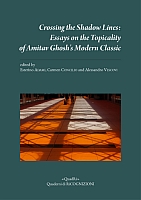Crossing the Shadow Lines
Essays on the Topicality of Amitav Ghosh’s Modern Classic

Contributor(s)
ADAMI, Esterino (editor)
Concilio, Carmen (editor)
VESCOVI, ALESSANDRO (editor)
Language
English; ItalianAbstract
Amitav Ghosh’s second novel, The Shadow Lines (1988), was notoriously conceived in 1984, in the aftermath of Indira Gandhi’s assassination, when Delhi was upturned by bloodthirsty mobs that attacked the Sikh community killing, raping, and looting. This was the “madeleine” that brought the would-be novelist (he was halfway through writing The Circle of Reason) back to 1964, when a similar mob attacked Hindus in Dhaka, where Ghosh, then a child, was living with his family. Thus The Shadow Lines became a historical novel about Bengal in the Sixties, a portrait of post-Independence India, a Bildungsroman, or indeed a Künstlerroman, about a young Bengali, an Indian reply to both Portrait of the Artist as a Young Man (1915) and Remembrance of Time Past (1922) that enthused a generation of Indian intellectuals. Indeed, The Shadow Lines is the first and so far only novel by a living author to be included in University syllabi all over India. Unsurprisingly this is, among Ghosh’s books, the most written about, especially in South Asia. The Shadow Lines has gained enormous resonance in postcolonial studies as it touches upon some of the major issues in the fields of colonial history, national identities, memory, and borders. Likewise, the novel has been seminal in the definition and discussion of a postcolonial geography that challenges the current cartographical order. It has drawn from the literary tradition of the past and has influenced new literary productions, as the variety of international scholarly essays in this collection demonstrate.
Keywords
essays; amitav gosh; modern classicDOI
10.13135/2420-7969/11Publisher
University of TurinPublication date and place
Turin, 2020Classification
Literary essays
Pages
210Chapters in this book
Rights
Metrics
Measures
Timeline
Geographical
Information
